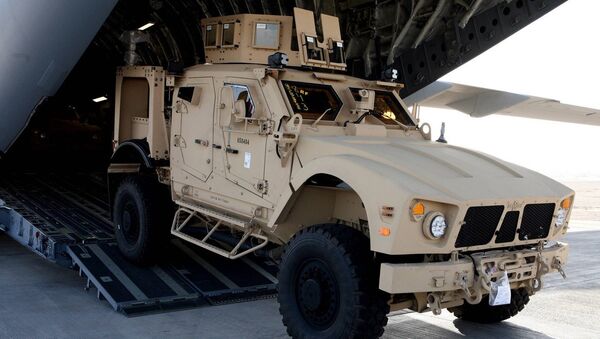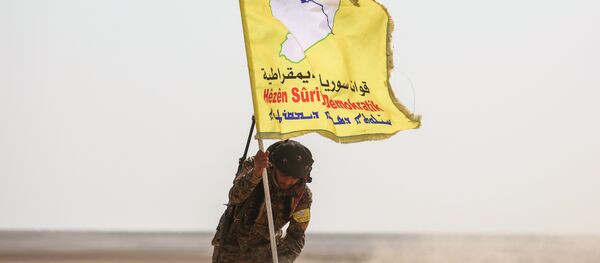The photos and videos were uploaded by Syrian Kurdish activists who are known affiliates of the Syrian Democratic Forces (SDF.) The vehicles included Mine-Resistant Ambush Protected (MRAP) vehicles, Mine-Resistant All Terrain Vehicles (M-ATVs) and armored bulldozers. They were mounted on the backs of flatbed trucks and were filmed passing through Qamishli, 170 miles northeast of Raqqa.
U.S armaments & military vehicles being delivered to SDF via trucks in Qamishlo city. pic.twitter.com/D9bKIbBVVV
— Afarin Mamosta (@AfarinMamosta) July 17, 2017
All three vehicle types were previously mentioned in Pentagon reports as assets being supplied to SDF fighters. "Up-armored vehicles have been delivered to the SDF and [Syrian Arab Coalition] as part of our existing authorities to enable them," a spokesperson for US operations in Syria told Task & Purpose.
U.S armaments & military vehicles being delivered to SDF via trucks toward Raqqa. pic.twitter.com/x49JUOZK8I
— Afarin Mamosta (@AfarinMamosta) July 19, 2017
"Specifically, these vehicles will help them contend with [Daesh's] IED threat in their current operation, and as they move to isolate [Raqqa]." Mine-resistant vehicles are deployed against areas known to hide improvised explosive devices, which are a major danger to American soldiers riding in armored vehicles. At least half of all US casualties in Iraq and Afghanistan have been attributed to IEDs.
U.S SOF military vehicles being transported via trucks towards Raqqa. #Rojava pic.twitter.com/C3GWnCYYd3
— Afarin Mamosta (@AfarinMamosta) July 17, 2017
However, the spokesperson went on to tell Task & Purpose that MRAPs and M-ATVs were "not part of the package that is divested to the SDF." The Military Times noted that the M-ATVs were mounted with Common Remotely Operated Weapon Station (CROWs) systems, which allow for operators to fire the M-ATV's mounted.50 cal machine gun without exposing themselves to enemy fire. CROWS systems also weren't provided to SDF fighters.
New pictures from #US deliveries of armoured vehicles to #PKK-affiliated #YPG that is stuck in #Raqqa fighting #ISIS. #Syria pic.twitter.com/Ys0B3QELFB
— Ali Özkök (@A_Ozkok) July 19, 2017
Instead, the vehicles "are for use by the Coalition to protect our forces from IEDs." In other words, the Pentagon claims these armored vehicles are for use by Western operators, not SDF militants.
Under the Trump administration, there has been an uptick in American support for the SDF, a coalition of various militias. Since June, the SDF have besieged Raqqa, Daesh's final stronghold in Syria. Although Daesh has mounted intense resistance, the SDF has encircled the city and is slowly but surely gaining ground. The deeper the SDF go into the city, however, the stiffer the defenses they find awaiting them.
"The SDF has reportedly encountered intensified resistance and 'better-emplaced defenses' over the past four weeks following initial rapid gains in districts on the outskirts of [Raqqa]," read a new report from the Institute for the Study of War.
Although the US support for SDF operations is common knowledge, the Pentagon has been very cagey about providing details of American operations. They only directly confirmed the presence of US advisers in Raqqa five weeks into the siege, for instance.
The largest and most prominent militia among them are the Syrian Kurdish People's Protection Units (YPG). Turkey, a nominal US ally, considers the YPG to be a terrorist group, which the US denies. The Syrian Kurds and the Turkish military have become increasingly belligerent to one another, with some exchanges of gunfire along the Syrian-Turkish border. Ankara has stated in no uncertain terms that they will never support a Kurdish state on their border.
The armored vehicles may then serve a purpose beyond helping to bring an end to the Daesh occupation. They may also be the Pentagon looking ahead to the wars of tomorrow.



